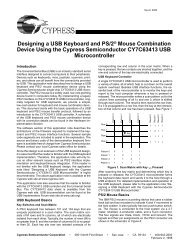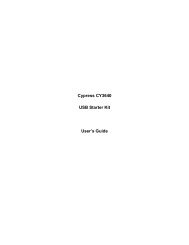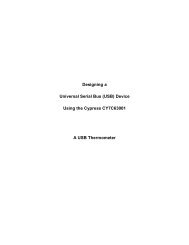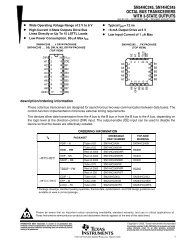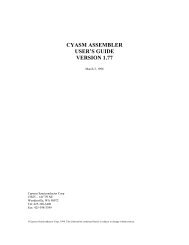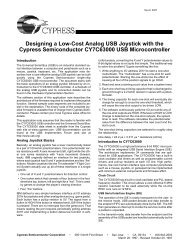<strong>Designing</strong> a <strong>USB</strong> <strong>Keyboard</strong>Configuration DescriptorThe configuration descriptor is 9 bytes in length and gives <strong>the</strong>configuration information for <strong>the</strong> device. It is possible to havemore than one configuration for each device. When <strong>the</strong> hostrequests a configuration descriptor, it will continue to read<strong>the</strong>se descriptors until all configurations have been received.A list of <strong>the</strong> structure follows:• Total length of <strong>the</strong> data returned for this configuration (2bytes)• Number of interfaces for this configuration (1 byte)• Value used to address this configuration (1 byte)• Index of string describing this configuration (Optional) (1byte)• Attributes bitmap describing configuration characteristics(1 byte)• Maximum power <strong>the</strong> device will consume from <strong>the</strong> bus (1byte)Example of configuration descriptorDescriptor Length (9 bytes)Descriptor Type (Configuration)Total Data Length (34 bytes)Interfaces Supported (1)Configuration Value (1)String Describing this Config (None)Config Attributes (Bus powered)Max Bus Power Consumption (100mA)Interface DescriptorThe interface descriptor is 9 bytes long and describes <strong>the</strong>interface of each device. It is possible to have more than oneinterface for each device. This descriptor is set up as follows:• Number of this interface (1 byte)• Value used to select alternate setting for this interface (1byte)• Number of endpoints used by this interface. If this numberis zero, only endpoint 0 is used by this interface (1 byte)• Class code (1 byte)• Subclass code (1 byte)• Protocol code (1 byte)• Index of string describing this interface (1 byte)Example of interface descriptorDescriptor Length (9 bytes)Descriptor Type (Interface)Interface Number (0)Alternate Setting (0)Number of Endpoints (1)Class Code (insert code)Subclass Code (0)Protocol (No specific protocol)String Describing Interface (None)HID (Class) DescriptorThe class descriptor tells <strong>the</strong> host about <strong>the</strong> class of <strong>the</strong> device.In this case, <strong>the</strong> device falls in <strong>the</strong> human interface device(HID) class. This descriptor is 9 bytes in length and is setup as follows:• Class release number in BCD (2 bytes)• Localized country code (1 byte)• Number of HID class descriptor to follow (1 byte)• Report descriptor type (1 byte)• Total length of report descriptor in bytes (2 bytes)Example of HID class descriptorDescriptor Length (9 bytes)Descriptor Type (HID Class)HID Class Release Number (1.00)Localized Country Code (USA)Number of Descriptors (1)Report Descriptor Type (HID)Report Descriptor Length (63 bytes)Endpoint DescriptorThe endpoint descriptor describes each endpoint, including<strong>the</strong> attributes and <strong>the</strong> address of each endpoint. It is possibleto have more than one endpoint for each interface. This descriptoris 7 bytes long and is set up as follows:• Endpoint address (1 byte)• Endpoint attributes. Describes transfer type (1 byte)• Maximum packet size this endpoint is capable of transferring(2 bytes)• Time interval at which this endpoint will be polled for data(1 byte)Example of endpoint descriptorDescriptor Length (7 bytes)Descriptor Type (Endpoint)Endpoint Address (IN, Endpoint 1)Attributes (Interrupt)Maximum Packet Size (8 bytes)Polling Interval (10 ms)Report DescriptorThis is <strong>the</strong> most complicated descriptor in <strong>USB</strong>. There is noset structure. It is more like a computer language that describes<strong>the</strong> format of <strong>the</strong> device’s data in detail. This descriptoris used to define <strong>the</strong> structure of <strong>the</strong> data returned to <strong>the</strong>host as well as to tell <strong>the</strong> host what to do <strong>with</strong> that data. Anexample of a report descriptor can be found below.A report descriptor must contain <strong>the</strong> following items: Input (orOutput or Feature), Usage, Usage Page, Logical Minimum,Logical Maximum, Report size, and Report Count. These areall necessary to describe <strong>the</strong> device’s data.Example of report descriptorUsage Page (Generic Desktop)Usage (<strong>Keyboard</strong>)Collection (Application)Usage Page(key codes)Usage Minimum (224)Usage Maximum (231)Logical Minimum (0)Logical Maximum (1)Report Size (1)Report Count (8) ; modifier byteInput (Data, Variable, Absolute)Report Count (1)Report Size (8)Input (Constant) ; reserved byte8
<strong>Designing</strong> a <strong>USB</strong> <strong>Keyboard</strong>Report Count (5)Report Size (1)Usage Page (LEDs)Usage Minimum (1)Usage Maximum (5)Output (Data, Variable,Absolute); LED reportReport Count (1)Report Size (3)Output (Constant) ;paddingReport Count (6)Report Size (8)Logical Minimum (0)Logical Maximum (101)Usage Page (key codes)Usage Minimum (0)Usage Maximum (101)Input (Data, Array) ;key array(6)End CollectionInput items are used to tell <strong>the</strong> host what type of data will bereturned as input to <strong>the</strong> host for interpretation. These itemsdescribe attributes such as data vs. constant, variable vs. array,absolute vs. relative, etc.Usages are <strong>the</strong> part of <strong>the</strong> descriptor that defines what shouldbe done <strong>with</strong> <strong>the</strong> data that is returned to <strong>the</strong> host. From <strong>the</strong>example descriptor, Usage (<strong>Keyboard</strong>) tells <strong>the</strong> host that thisis a keyboard device. There is also ano<strong>the</strong>r kind of Usage tagfound in <strong>the</strong> example called a Usage Page. The reason for <strong>the</strong>Usage Page is that it is necessary to allow for more than 256possible Usage tags. Usage Page tags are used as a secondbyte which allows for up to 65536 Usages.Logical Minimum and Logical Maximum are used to bound<strong>the</strong> values that a device will return. For example, a keyboardthat will return <strong>the</strong> values 0 to 101 for <strong>the</strong> scan code of eachkey press will have a Logical Minimum (0) and Logical Maximum(101). These are different from Physical Minimum andPhysical Maximum. Physical boundaries give some meaningto <strong>the</strong> Logical boundaries. For example, a <strong>the</strong>rmometer mayhave Logical boundaries of 0 to 999, but <strong>the</strong> Physical boundariesmay be 32 to 212. In o<strong>the</strong>r words, <strong>the</strong> boundaries on <strong>the</strong><strong>the</strong>rmometer are 32 to 212 degrees Fahrenheit, but <strong>the</strong>re areone thousand steps defined between <strong>the</strong> boundaries.Report Size and Report Count define <strong>the</strong> structures that <strong>the</strong>data will be transferred in. Report Size gives <strong>the</strong> size of <strong>the</strong>structure in bits. Report Count defines how many structureswill be used. In <strong>the</strong> example descriptor above, <strong>the</strong> lines ReportSize (8) and Report Count (6) define a 6 byte key arrayfor a keyboard.Collection items are used to show a relationship between twoor more sets of data. For example, a minimal keyboard canbe described as a collection of four data items (Modifier byte,Reserved byte, LED report, and Key Array). End Collectionitems simply close <strong>the</strong> collection.It is important to note that all examples given here are merelyfor clarification. They are not necessarily definitive solutions.A more detailed description of all items discussed here aswell as o<strong>the</strong>r descriptor issues can be found in <strong>the</strong> “DeviceClass Definition for Human Interface Devices (HID)” revision1.0 and in <strong>the</strong> “Universal Serial Bus Specification” revision1.0, chapter 9. Both of <strong>the</strong>se documents can be found on <strong>the</strong><strong>USB</strong> world wide web site at http://www.usb.org/.FunctionalityMain LoopThe main loop of <strong>the</strong> firmware (Figure 20) waits for <strong>the</strong> keyboardScan Task to be scheduled by <strong>the</strong> 1 ms ISR (Figure 25),and <strong>the</strong>n executes it. Reports are sent to <strong>the</strong> host via EndPoint 1 anytime a key is pressed or released. The host sidesoftware will repeat <strong>the</strong> key press until <strong>the</strong> release of <strong>the</strong> keyso that <strong>the</strong> device does not require a continuous report whenno key status changes have occurred.Scan TaskThe Scan Task (Figure 21) determines if <strong>the</strong>re were any keystatus changes from <strong>the</strong> previous scan (i.e. key presses orreleases) and calls <strong>the</strong> KeyChanged routine (Figure 22) foreach column of <strong>the</strong> scan matrix that had changes in any of<strong>the</strong> row positions. The KeyChanged routine calls <strong>the</strong>FoundKey routine (Figure 24) for each row that <strong>the</strong>re waschange in status. The FoundKey routine calculates an indexbased upon <strong>the</strong> row and column of <strong>the</strong> key, does a lookup ina KeyCodeTable for its usage (scan) code, and stores it in <strong>the</strong>End Point 1 FIFO. After all columns have been scanned, <strong>the</strong>Scan Task calls <strong>the</strong> SendKeys routine (Figure 23) if a reportis required to be sent to <strong>the</strong> host.DebounceThe mechanical switch properties of <strong>the</strong> key switches cause<strong>the</strong>m to bounce after a key press. These bounces may bemistaken for actual key events. See Figure 18.Row i SignalKey i, j pressedSwitch bouncesKey i, j releasedTimeFigure 18. Key Switch BounceTo solve this problem, all keys that are pressed have <strong>the</strong>ircode stored in a Debounce FIFO at <strong>the</strong> location pointed to by<strong>the</strong> Debounce Pointer (<strong>the</strong> reference firmware uses a 4-elementFIFO). The 1 ms ISR updates and clears <strong>the</strong> currentposition in <strong>the</strong> Debounce FIFO every 12 ms. Every key thathas a status change (i.e. pressed or released) is searched forin <strong>the</strong> Debounce FIFO. If <strong>the</strong> key is found, <strong>the</strong> status changeis ignored. In o<strong>the</strong>r words, any status change for 12*4= 48 msafter a key is pressed is considered to be caused by switchbounces, and should be disregarded. Different keyboards willhave varying key switch sensitivity, and <strong>the</strong> length of <strong>the</strong> DebounceFIFO may vary. The firmware uses <strong>the</strong> constantDEB_HI_ADDR to set <strong>the</strong> length of <strong>the</strong> FIFO.9



